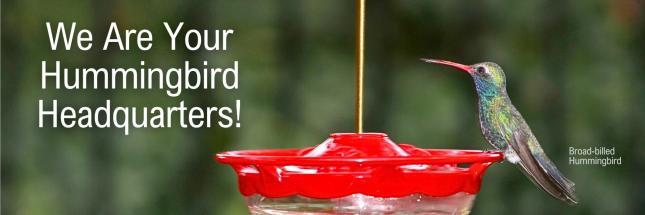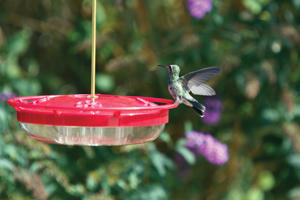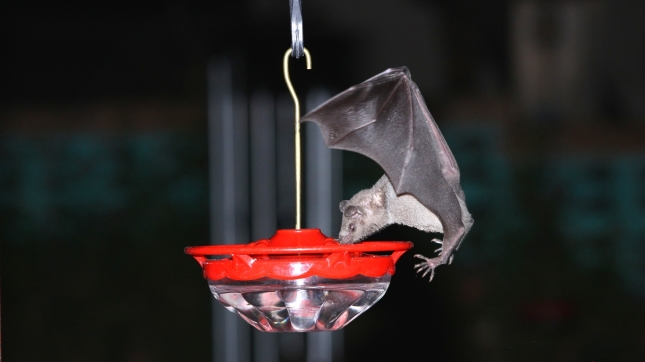
Attracting Hummingbirds In Tucson
Hummingbirds are truly some of the most amazing creatures on the planet. Individually, they are the smallest of all birds, and yet, with over 320 species, they are the second largest family of birds in the world.
Hummingbirds differ from other birds in a variety of ways. They have weak feet and legs that are used more for perching than walking. They are most comfortable in the air, and they are capable of hovering as well as flying up, down, forward and backward.
These tiny birds use so much energy flying that they can eat double their weight in nectar and insects each day.
Despite popular belief, hummingbirds do not suck up nectar with their bills. They actually lap it up with their tongues. While dipping their grooved tongues into nectar sources at up to 12 times a second, the nectar is drawn up and into their mouth each and every time.
You can help them keep their energy level up and attract them to your garden by offering them a nectar solution.
Create Your Own Nectar Solution. Mix four parts water and one part ordinary table sugar to create the perfect nectar solution. Example: (4 cups of water, 1 cup of sugar) Processed and refined cane or beet sugar are the recommended options. Avoid using raw sugar, brown sugar, artificial sweeteners, honey or food coloring. It's ok to store nectar in the refrigerator, but not longer than 2 weeks. If you must purchase nectar, WBU brand Hummingbird & Oriole Nectar has no dyes or preservatives and is safe for your birds. Other brands may contain dyes or preservatives.
Cleaning Your Feeder: Every 3 to 4 days, dump the unused nectar and clean the feeder with white vinegar or hydrogen peroxide, using a cleaning brush. This safely eliminates microorganisms. Rinse thoroughly and let dry before refilling. Hot, soapy water is okay only if the detergent is rinsed thoroughly. Soap residue may not be safe for the birds. If you have a Wild Birds Unlimited brand Hummingbird Feeder, simply place it in the top drawer of your dishwasher for easy cleaning.
 Leave your feeder out all year long! Your feeders will be as busy during the winter months as they are in the summer. Some of our hummingbird species such as costa's, anna's and broad-billed are not migratory and will visit your feeder all 12 months of the year. While eating at your feeders, hummingbirds are also utilizing the nectar from flowers in your neighborhood. However, expect activity at your feeders to slow down a bit during the spring wildflower season, when nectar from flowers is more widely available. Generally, our feeders are busiest during the coldest winter months and during the monsoonal months of June through September.
Leave your feeder out all year long! Your feeders will be as busy during the winter months as they are in the summer. Some of our hummingbird species such as costa's, anna's and broad-billed are not migratory and will visit your feeder all 12 months of the year. While eating at your feeders, hummingbirds are also utilizing the nectar from flowers in your neighborhood. However, expect activity at your feeders to slow down a bit during the spring wildflower season, when nectar from flowers is more widely available. Generally, our feeders are busiest during the coldest winter months and during the monsoonal months of June through September.
Expect a variety of visitors. The desert is full of nectar-loving birds and mammals. Woodpeckers, verdins, orioles, bats and even house finches will be attracted to your offering. In fact, woodpeckers and verdins are two of Tucson's most common nectar-eating birds.
Solving hummingbird feeding issues. 
- Dripping feeders. All hummingbird feeders are prone to a minimal amount of dripping due to larger bird activity, bats, high winds, etc. However, dripping can become a bigger problem when using the inverted, bottle-style feeders. As daytime temperatures rise, the expanding nectar inside the bottle forces the nectar level to rise in the base, causing dripping.
- Bees and insects. Often, eliminating a dripping problem can rectify an insect issue such as bees. However, there are many smaller flying insects that can easily get through the feeding ports of hummingbird feeders. This problem can be solved by using the nectar guard tips that fit on the ports of our Wild Birds Unlimited High Perch feeders. To deter crawling insects such as ants, our High Perch feeders have a built-in ant moat that, when filled with water, prevents ants from reaching the nectar ports. Individual ant moats are also available which can be used to keep ants off most any hummingbird feeder.
- Hummingbirds have stopped using the feeder. The most common cause is nectar fermentation which starts occurring several days after the nectar is freshly made. Hummingbirds will avoid fermented nectar and move on to other feeding sites. In March and April, hummingbirds visit feeders less frequently when the availability of wildflowers increases. During particularly good wildflower years, hummingbirds may stop using your feeder altogether for a few weeks. During period of slow feeding, it is important to continue cleaning feeders at least 2 times a week.

